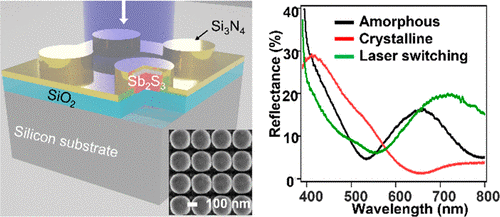SUTD sets its sights on chalcogenide nanostructured displays
SUTD - Li Lu, Hongtao Wang, Soroosh Daqiqeh Rezaei, Yunzheng Wang, Joel K. W. Yang, and Robert E. Simpson
A*STAR - Zhaogang Dong, Febiana Tijiptoharsono, Ray Jia Hong Ng, Hai Sheng Leong and Poh Chong Lim.
An Earth abundant material, antimony trisulphide, shows potential for high resolution video displays.
 Illustration of the antimony trisulphide programmable metasurface and its reflection spectrum in multiple states.
Illustration of the antimony trisulphide programmable metasurface and its reflection spectrum in multiple states.
One of the key components behind next-generation high resolution video displays will be optical nanoantennas. These devices use nanotechnology to mix and interfere with light beams to produce colour and even holograms.
While optical nanoantennas using silicon or similar materials have produced colour images, the images are fixed and cannot be tuned back and forth. However, new materials with tuneable properties are required to exploit optical nanoantennas in high resolution videos.
To address this gap, research teams from the Singapore University of Technology and Design (SUTD) and A*STAR IMRE designed and demonstrated the use of chalcogenide nanostructures to reversibly tune Mie resonances in the visible spectrum. With its width measuring at just 190nm - 1000 times smaller than a single strand of human hair - the chalcogenide nanodisc can be switched between two optical states using heat to induce phase transitions.
Their work 'Reversible Tuning of Mie Resonances in the Visible Spectrum' was published in ACS Nano.
“We demonstrate phase change nanodiscs’ ability to interfere and manipulate visible light – that is the first step towards a video hologram display,” explained Associate Professor Robert Simpson, the principal investigator at SUTD.
The technology relies on phase change materials; materials which are more typically used in data storage devices. Instead of using phase change data storage materials, such as the germanium–antimony–tellurium alloys, the research team explored the use of an Earth abundant material called antimony trisulphide. The team showed that the optical properties of antimony trisulphide nanoparticles can be switched at a high speed to create tuneable vivid colours.
However, using a new material came with its set of challenges. The team needed to develop a new nanofabrication method to create antimony trisulphide nanostructures with specific optical properties and resonances.
Additionally, they had to ensure that the optical properties and resonances of the antimony trisulphide nanoparticles could be reversibly switched. They used femtosecond laser pulses to switch the optical state of these particles. Substantial optimisation was also necessary to find the conditions that would lead to reversible switching without vaporising the nanoparticle structures.
While this work paves the way towards high resolution colour displays, holographic displays and miniature LiDAR scanning systems, the research team is also excited to extend this new phase change material to other programmable photonics applications and foster collaborations to realise the full potential of antimony trisulphide and related materials.
“Our work clearly demonstrates that reversible switching is possible, but for practical devices, we also need to develop an elegant, integrated system to electrically address and control the optical state of the nanoparticles. We are currently working on these technologies, and we hope that this paper will inspire the wider research community to further extend the capabilities of these important chalcogenide nanoparticles,” added Associate Professor Simpson.
Acknowledgements:
This work is supported by the funding support of A*STAR AME IRG project with a project number of A20E5c0093. In addition, R.E.S., Y.W., and L.L. acknowledge funding support from the Nano Spatial Light Modulators (NSLM) AME grant (A18A7b0058). Z.D. also would like to acknowledge the funding support from the A*STAR career development award (CDA) with the grant number of 202D8088. J.K.W.Y. would like to acknowledge the funding from National Research Foundation (NRF) Singapore with the grant numbers of NRF-CRP20-2017-0001 and NRF-NRFI06-2020-0005.
Reference:
Reversible Tuning of Mie Resonances in the Visible Spectrum, ACS Nano 2021 15 (12). (DOI: 10.1021/acsnano.1c07114)